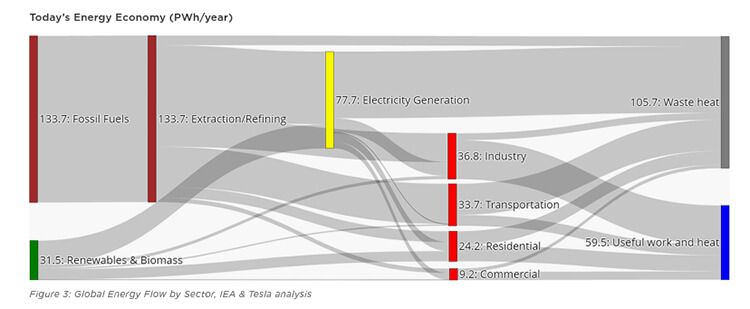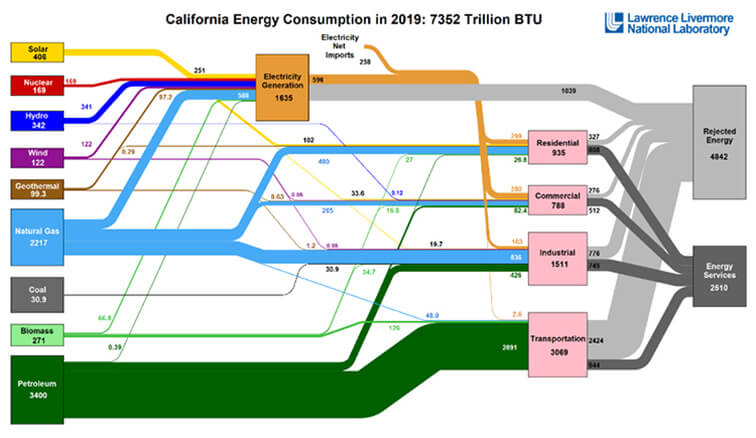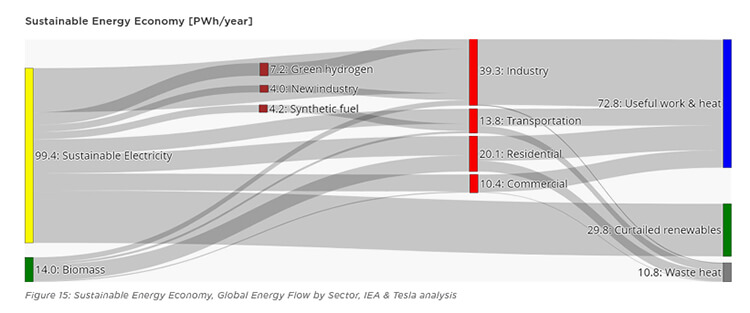Whatever else critics may say about Elon Musk—e.g., he’s an eccentric tycoon, adroitly hogging the trough of government subsidies—he is nonetheless an extraordinary entrepreneur who will be remembered by history as perhaps the most brilliant industrialist of the 21st century. So it is encouraging to hear this influential billionaire claim humanity can move into a future of sustainable abundance. This sets Musk apart from virtually every other member of the global elite, not merely because of his optimistic rhetoric but because of his achievements.
Those of us who remain skeptical of both the potential of “renewables” to deliver the energy required by civilization, as well as of the motives of those who promote them, should evaluate Musk’s case for sustainable abundance. Many of his claims are indisputable, and separating those solid assertions from the more dubious ones can be enlightening.
When Musk says the planet can sustain a population much larger than the current 8 billion, most conservatives would agree with him. His outlook is supported by the evidence of history, known reserves of mineral and fuel resources, and the potential for ongoing innovation.
The debate, once you dispense with a Malthusian mindset, is over how best to achieve worldwide prosperity. Specifically, what technology choices offer the most cost-effective and practical path to abundant and affordable energy? Musk’s choice is to electrify everything.
While much of the support for electrifying everything is based on achieving “net zero,” and much of Tesla’s “Master Plan Part 3, Sustainable Energy for All the Earth” attempts to show how each economic sector can be electrified, there is a case for electrification that has nothing to do with concerns about fossil fuel emissions and the climate.
It rests instead on the inherent efficiency of electricity versus combustion.
To understand the reasoning behind this claim, one must make a distinction between the amount of energy put into any device and the amount of useful energy that device delivers. For example, Musk makes a case for electrification based on the fact that both heat pumps (for heating and cooling) and electric motors will deliver the same amount of useful heating, cooling, and traction using one-third as much electricity when compared with fossil fuel. That is, an electric heat pump is three times more energy efficient than a gas furnace, and an electric motor uses energy three times more efficiently than a gasoline engine.
The following flow chart, compiled by Tesla using data from the International Energy Agency (IEA), shows how energy inputs (on the left)—fossil fuels, renewables, and biomass—are converted either into electricity or directly into useful heat and motion in the four primary economic sectors: industry, transportation, residential, and commercial. Using petawatthours as the primary energy unit, what is most pertinent in this flowchart is the fact that only one-third of the energy put into the system as fuel comes out the other end as useful work. Two-thirds is lost to friction and heat.

Tesla’s compilation is validated by other analyses and is beyond serious debate. The next flowchart shows the same analysis as compiled by Lawrence Livermore National Laboratory. This also uses data from the IEA, this time from 2011, but shows the energy inputs broken out by wind, nuclear, hydro, solar, geothermal, natural gas, coal, biomass, and petroleum. The boxes on the left, by the way, are not proportional to the amount of energy they represent, but the numbers within the boxes reveal accurate proportions.
Summing them up, non-combustion energy inputs in 2011 only contributed 8 percent to global energy input. More to the point, on the right side of the flowchart, the ratio between “rejected energy” versus “energy services” corroborates with Tesla’s analysis. The world’s current energy technologies can only harvest and use about one-third of their raw energy input.

It’s the Energy Output That Counts
The opportunity indicated by the data in these flowcharts is clear enough. If electricity can convert energy inputs into energy outputs at a higher level of efficiency, then people can enjoy the same energy services while consuming far less raw fuel. The next flowchart, coming from Tesla’s plan, depicts a hypothetical global energy economy based on total electrification. The primary takeaway from this chart is its estimate that in an electrified economy, two-thirds of the raw fuel inputs can be converted into useful work—heat, traction, etc.—versus only one-third in a mostly combustion-based economy. Based on current technologies, this is a plausible estimate; it may even be a low estimate.

There are, however, at least two cautionary qualifications to all this enthusiasm for electrifying the global economy.
The first concerns just how much energy will be required to enable an adequate standard of living for everyone on Earth. For example, when converting all units of energy—such as gasoline and natural gas—into equivalent units of electricity, per capita end use of energy by Americans in 2021 was 29,041 kilowatt hours. It is reasonable to expect that at an absolute minimum, a reasonable target for per capita net energy consumption worldwide will need to be around half that much, or 15,000 kilowatt hours per person per year. For 8 billion people, that adds up to 120 petawatt-hours, or 160 percent of what Tesla estimates will be necessary.
To be clear, this 15,000-kilowatt-hour target is not energy input, it’s based on half of what Americans consume per capita after implementing the ultra-efficient electrification of their economy. So it isn’t valid to suggest that everyone on the planet will attain a quality of life equivalent to Americans, even if they only attain an energy end-use consumption of half as much as Americans currently enjoy.
To live with half as much end-user energy services means to cut back. That is baked into these numbers. Less end-use energy means less industry, less transportation, and fewer household comforts and consumer goods. We can debate the virtues of a rationed world, but delivering half as much net energy globally as Americans currently enjoy is not abundance.
As it is, Tesla’s projections estimate only 9,100 kilowatt hours of net energy per person per year in their vision of a built-out, electrified world, which is only one-third of what Americans consume. Realistically, the electrified world Tesla is envisioning will probably need to deliver about twice as much energy—around 140 petawatt-hours per year—to enable the abundance they rightly claim is feasible.
How Will Electricity Be Produced?
It’s fair to acknowledge that unforeseen energy innovations may drive the threshold for global energy abundance down closer to 72 petawatt-hours per year than the level that, at present, seems necessary: 140 petawatt-hours per year.
But when it comes to global electrification, what devices will be generating and consuming those petawatt-hours is the other big question. While Elon Musk’s optimism about resource availability is commendable, it is not at all clear that the resources required to produce “renewable” electricity derived from wind turbines and solar panels, as well as the resources to consume electricity, for example, in the form of all-electric vehicles, would require fewer resources than are currently used to produce conventional energy in all its forms.
To properly verify the assertions made in Tesla’s “Materials Required” tables would require sourcing multiple reports on material intensity in wind turbines, solar panels, transformers, transmission lines, and batteries, reserves of at least 20 critical raw materials needed to manufacture these products, data on current levels of raw materials extraction, and estimates of how new technologies may reduce the required quantities of materials. That’s not easy, to say the least, but Tesla’s plan takes a stab at it.
In Figure 17 of the Tesla Plan, two graphs reveal an ironic optimism regarding availability of critical materials. The first graph, “What People Think Happens,” shows “Global Reserves” on the vertical axis, and years 2002 through 2022 on the horizontal axis. The line slopes downwards to reflect the common assumption that we will run out of minerals. The second graph, “What Actually Happens,” shows global reserves of critical materials trending upwards instead of downwards along these same axes. There’s irony here because this is the argument proponents of fossil fuels have been making—and validating—for years. And it’s revealing that they feel they have to make this argument at all.
Plenty of researchers challenge Tesla’s claim that fewer raw materials are required for the solar- and wind-powered economy than for an all-of-the-above energy economy that also utilizes nuclear, hydroelectric, and gas/oil/coal. They would include Peter Ziehan in his many publications including, The End of the World Is Just the Beginning: Mapping the Collapse of Globalization, Alex Epstein in Fossil Future: Why Global Human Flourishing Requires More Oil, Coal, and Natural Gas–Not Less, and Robert Bryce in his podcast and recent book A Question of Power: Electricity and the Wealth of Nations. The perspective of these and other reputable critics of precipitous conversion to wind, solar, and all-electric vehicles is a necessary balance to studies such as the Tesla Plan.
If there is a shortage today of anything, it would be people willing and able to criticize the green “net zero” bandwagon that has coopted every opportunistic politician and profit-driven corporate special interest in the Western world. Properly analyzing and critiquing Tesla’s Plan for converting the world to a “net-zero” electrified economy would require effort commensurate to the effort that went into writing it. It’s a big job.
Who will question the glib suggestion that 111,563 square miles of photovoltaic installations and 14,375 square miles of wind turbines will not have debilitating and climate-altering impacts through the heat island effect of the solar farms, and weather-altering energies being subtracted from the tradewinds? Who will question the absolutely preposterous, ridiculously, scandalously false, agenda-driven estimate that only 14,375 square miles is all it will take to produce 12,200 gigawatts of wind-generated electricity?
Elon Musk is right about one thing: There is a clear path to a fully sustainable Earth, with abundance, and the planet can easily support a population well in excess of the current 8 billion. But getting there through an all-of-the-above energy strategy is the most efficient path.
Wind, solar, and battery technologies have made impressive strides in recent years, but without the “climate crisis” and “net-zero” hysteria, they would be displacing other competing forms of energy based on their economic viability instead of through politics. If everything Musk and his company’s report has to say is true, the path to a net-zero electric age would not require one bit of government coercion or subsidies. And that is how it should be.
